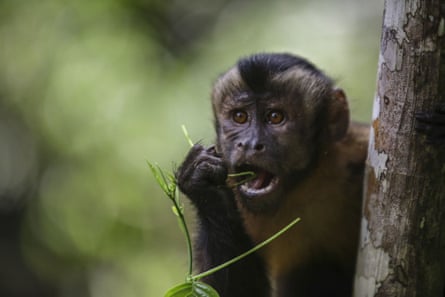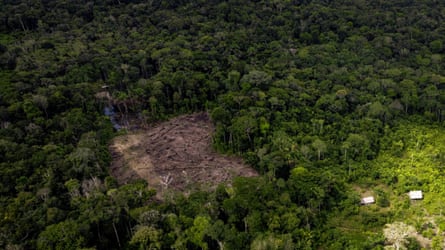As the tiny aeroplane wobbles, shudders and occasionally plummets in the low-altitude turbulence, Rodrigo Botero points to the scars left by Colombia’s failed efforts to halt a surge in deforestation in the Amazon rainforest over the past six years.
The conservationist shouts into his radio earpiece and gestures at the window towards uniform, neatly cut pastures that have been cleared for cattle ranching.
Grey smoke drifts upwards into the sky from patches where land-grabbers are burning off the undergrowth – a common sight after a 2016 peace accord sparked a free-for-all in Colombia’s forests.
“A year ago the columns of smoke were so great that we couldn’t even breathe in the cockpit,” recalls Botero, who is leading an aerial survey of Colombia’s Amazon rainforest and directs the Foundation for Conservation and Sustainable Development (FCDS).
Today, however, it is harder for Botero to point out recent deforestation and the veteran conservationist has some good news for a visiting delegation of Norwegian government officials: Colombia could finally be turning the tide on deforestation in the Amazon.
“This is really dramatic,” he says excitedly. “It’s the highest reduction in deforestation and forest fires that there has been in two decades.”
Government figures released on Wednesday show that deforestation is slowing nationwide, falling 26% in the Colombian Amazon last year and 29% across the country.

Officials say the 50,000 hectares of forest saved in 2022 are an early result of what is probably the first peace process in history to put the environment at the centre.
“This is just the beginning,” Colombia’s environment minister, Susana Muhamad, told the Guardian while visiting the southern state of Guaviare. “I think that Colombia can [overcome] deforestation in the Amazon and turn this all around.”
When the Colombian government signed a peace accord with the Revolutionary Armed Forces of Colombia (Farc) in 2016, it formally ended six decades of internal conflict that killed 450,000 people.
But as 7,000 Farc guerrillas laid down their weapons, it also created a new and unexpected victim: the country’s forests. Other armed groups – including dissident rebel factions who rejected the deal – took advantage of the Farc’s absence to flatten hundreds of acres at a time in vast land grabs.
Despite large-scale military operations and international pressure, successive governments have struggled to reduce deforestation, particularly in the Amazon.
“The consequence of the peace process has been a great environmental disaster,” said Muhamad, a former environmental activist.
The mistake, say negotiators who brokered the 2016 peace accord, was seeing the environment as a possible beneficiary of the peace agreement – not as a key part of the agreement itself.
“With hindsight, we probably should have put more emphasis on that in the early negotiations,” Espen Barth Eide, Norway’s environment minister, told the Guardian while on a recent trip to Colombia’s jungle frontier.
Led by its first ever leftist president, Gustavo Petro, the Colombian government is now trying a fresh approach.
Petro has pledged to bring “total peace” to the country through dialogue with the many armed groups which have sprung up or regrouped since the Farc disbanded.
As part of those talks, he hopes to also protect the environment.
“Unlike the previous peace process, the environment will be a protagonist in these peace agreements,” Muhamad said.
Guaviare state is the center of one of the government’s key peace negotiations and a key battleground in efforts to save the Amazon.
The region marks the end of Colombia’s arid plains – colonised almost entirely by vast cattle ranches – and the beginning of the largely pristine Amazon rainforest, which is home to thousands of animal species and several uncontacted tribes.

Its dense jungles recently made international news when four children somehow survived 40 days alone after their plane crashed into the rainforest.
Environmental experts say deforestation plummeted here on the orders of a dissident rebel faction – and the region’s de facto authority – known as the Estado Mayor Central, or Central Command (EMC).
The group, composed of former Farc fighters, has ordered local farmers to stop cutting down trees as a “gesture of peace” in the hope of reaching a peace of agreement with the Petro government.
Such talks still have a long way to go, but the moratorium on logging has excited conservationists like Botero.
“It’s unprecedented,” he says. “We’ve never had this as the first step in negotiations.”
Colombia’s high peace commissioner announced on 8 July that informal talks were progressing and the government would soon open formal peace negotiations with the rebels.
Reaching an agreement with the EMC could rapidly reduce Amazon deforestation as it holds power over vast swathes of jungle in Guaviare, Caquetá and Putumayo states –and even across the border in Venezuela.
Government officials are already discussing more ambitious schemes for restoring the rainforest, including monthly payments for farmers who do not clear trees and training in harvesting Amazonian fruits.
To try to lock in the environmental gains, Muhamad is visiting remote regions like Guaviare that have been largely ignored by the governments of the past.
“Please excuse us for talking so long, but we’ve never had this opportunity,” one community leader says three hours into a public meeting attended by Muhamad and the high peace commissioner, Danilo Rueda. “Normally they just come, they take their photos and they leave.”
Among the farmers seated on plastic chairs in the sticky heat are informants for the EMC, say those involved in negotiations.
It is cause for optimism that the deforestation ban was not imposed on the armed groups by the government, Barth argues. Rather, the idea came from the dissidents themselves – a sign that the warring factions, like local communities, are increasingly understanding the need to protect local biodiversity.
“What I’m hearing, seeing and feeling in these meetings is that there is an enhanced understanding that you cannot build a new Colombia on the basis of the further deterioration of nature, so you have to find an economic, social, political, inclusive process that is more respectful towards nature than before,” Barth says.
But the EMC is not the only player warring for Colombia’s countryside.
Between them, five armed groups and 20 gangs have about 15,000 fighters, according to the government.
Analysts are skeptical that all the groups are genuinely interested in abandoning their criminal enterprises for peace.

“It’s like a chess game being played on several different boards simultaneously, each one with its own enormous complexity,” says Diego Alejandro Restrepo, at the Bogotá-based peacebuilding thinktank Pares.
In May the government suspended its ceasefire with the Clan del Golfo as Petro said Colombia’s biggest drug trafficking cartel continued “sowing anxiety and terror”.
As the plane flies deeper into the Amazon, the difficulty of Colombia’s “total peace” plan becomes apparent.
About 10 kilometres from the edge of Chiribiquete national park, a pristine mountainous landscape resembling the imaginary worlds of Avatar, clearings spanning hundreds of hectares in size suddenly come into view.
While the EMC has publicly ordered farmers to stop chopping down trees, it appears it has quietly continued taking money from mafiosi for land grabs and cattle ranching.
“We need to keep a close eye on this,” Botero says. “It can’t be that campesinos don’t burn, clear or anything at all while these great estates keep growing.”
